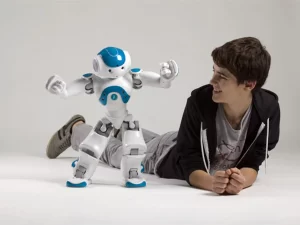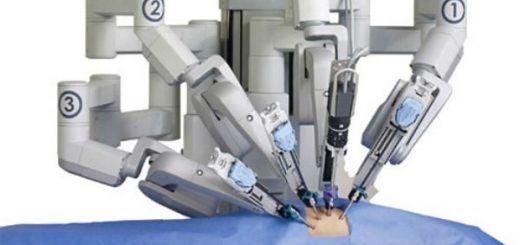NAO Robot review, features, advantages and disadvantages
Nao robot is an autonomous, programmable, medium-sized humanoid robot. It was designed to walk smoothly, even when changing speed and direction, The walking speed is similar to the walking speed of 2-year-old children, which is about 0.6 km/h. It was formerly developed by Aldebaran Robotics, a French robotics company headquartered in Paris, which was acquired by SoftBank Group in 2015 and rebranded as SoftBank Robotics.
Nao Robot
NAO robot is a programmable and handy robot, It is integrated with the world of cutting-edge technologies, It is an ASD Therapy Assistant and a classroom companion. The humanoid bipedal robot, NAO can help revolutionize several industries, such as education, healthcare, and entertainment, It is referred to as “multi-purpose,” NAO is one of the most renowned products available in the market.
Nao robot can perform a rich panel of movements with smoothness and precision and a certain degree of interactive autonomy, NAO is modular, referring to actuator modules that can be used for different joints, The head of the NAO robot can be unplugged and replaced by a more specialized one, Hands and fore-arms can be changed.
Nao robot advantages
NAO robot is the first robot created by Aldebaran, Famous around the world, It is used as an assistant by companies and healthcare centers to welcome, inform and entertain visitors, and it comes with Two 2D cameras to recognize shapes, objects, and even people. Nao robot is a small humanoid robot designed to interact with people, It’s packed with sensors and it can walk, dance, speak, and recognize faces and objects.
Now in its sixth generation, Nao robot is used in research, education, and healthcare all over the world. Nao robots are used by schools, colleges, and universities to teach programming and conduct research into human-robot interactions, they are used in many healthcare scenarios, including usage in care homes and schools.
Nao robots are used by educational and research institutions in 70 countries, they are used for customer service in Japanese bank branches, they are used to demonstrate a basic form of self-awareness in a philosophical experiment at Rensselaer Polytechnic Institute in New York, Nao robots can test a system of robotic “autobiographical memory” designed to help train International Space Station crews and assist elderly patients.
NAO helps teachers and students to foster deeper understanding and learning. Robotics can be used to show students that engineering and IT can be fun by making abstract knowledge concrete, robots enhance creative problem-solving skills and encourage the development of essential communication and interpersonal skills, they help develop the student’s ability to collaborate and convey complex ideas to their peers.
NAO robots performed complex operations, such as voice recognition, with ease. Students are intellectually engaged when working with the robot. NAO robot is a robot with a knack for knowledge, both learning and sharing it, NAO robot is a programmable personal teaching assistant, that helps teachers bring lessons to life, It makes learning more fun and more concrete for students.
Engagement with humanoid robots promotes curiosity, challenge, critical thinking, creativity, collaboration, and communication, NAO forms real relationships with students, It is interactive, intuitive, and friendly, It is designed to grab students’ attention, win their trust, and keep them invested, It doesn’t just know, It has personality, with patience and positivity to inspire students to keep focused and keep trying, It makes learning more active and engaging.
NAO robot can encourage participation, teamwork, and creative problem-solving, It helps students of all ages, It can work with students from preschool through grad school, It can show STEM students the power of programming, or offer extra support and attention to children with special needs, It gathers knowledge as well as shares it.
NAO robot is designed to be personalized, it’s easy to add new content, capabilities, and skills, Teachers around the world are using NAO to inspire students, improve teamwork, and increase both interest and knowledge of STEM skills for the future, NAO robot can interact and connect with people, NAO can be used by researchers looking to conduct experiments, collect data, and test theories.
Nao robot is a bipedal robot with pleasantly rounded features, It can track objects and recognize speech, It can detect falls and triggers protection, It can stand up on its own, It can communicate clearly and effortlessly with students across a variety of cultures, Tactile sensors in NAO’s head, hands, and feet help NAO robot react and respond as needed, NAO robot can hear, see, and recognize you – both who you are, and what you’re feeling. NAO robot is built to move naturally and go just about anywhere, It can detect obstacles, avoid falls, and get right back up again.
NAO6 robot features
Humanoid NAO6 has software Suite Licenses (including Choregraphe, Monitor, and SDK), and 2 years warranty, The programmable humanoid NAO6 robot is available in only one colour: dark grey. NAO robot has custom-designed integrated circuits based on Microchip 16-bit dsPICs microcontrollers, designed to control the actuators, These circuits are responsible for servo-control, bus control, sensor management, and power converters.
NAO6 robot will benefit from Pepper’s autonomous features such as the diagnosis effects, the sleep mode, and other autonomous abilities that make it look alive, The feature “qicli info” helps people who want to test things very quickly on the head of the robot without having to code the application or the script.
NAO6 takes benefit of all the Dialog and QiChat enhancements including a semantic engine (knowledge API + sentence structure) that allows the robot to give clearer and more coherent answers, Interaction with the robot is much improved, and New cameras can improve tracking and people detection performances, The dual stream of the top and bottom cameras is supported.
Programmable humanoid NAO6 specifications
Humanoid NAO6 has dimensions of 574x 311x 275 mm (22.6 x 10.8 x 12.2 inches), It weights 5.48 Kg (12,08 lb), It has Autonomy of 60 minutes in active use at 90 minutes in normal use, Degrees of freedom: 25, Processor: Intel Atom E3845, Compatible OS: Windows, Mac OS, Linux, Embedded: C++, Python, Remote: Java, Vision: 2 OV5640 2592×1944 cameras, Connectivity: Ethernet, Wi-Fi.
Nao robot design
The Nao robot is controlled by a specialized Linux-based operating system, dubbed NAOqi, The OS powers the robot’s multimedia system, which includes four microphones (for voice recognition and sound localization), two speakers (for multilingual text-to-speech synthesis) and two HD cameras (for computer vision, including facial and shape recognition), Nao robot has a software suite that includes a graphical programming tool dubbed Choregraphe.
Actuator unit design
The motors used for the NAO actuators are Maxon coreless brush DC motors, known for precision and reliability, NAO robot has spur and planetary gears to have good back drivability, It has special plastics that are loaded with PTFE (Polytetrafluoroethylene) and carbon fiber was used to meet torque and longevity requirements. NAO robot groups two rotary joints to make a Universal joint module that includes packaging, This allows costs to be reduced and takes into account the mechanical constraints imposed by the outer shell.
NAO robot has 25 degrees of freedom which enables it to move and adapt to its environment, It comes with 7 touch sensors located on the head, hands, and feet, It has sonars and an inertial unit to perceive its environment and locate itself in space, It contains 4 directional microphones and speakers to interact with humans, It comes with Speech recognition and dialogue are available in 20 languages, which are English, French, Spanish, German, Italian, Arabic, Dutch, Portuguese, Czech, Finnish, Russian, Swedish, Turkish.
Computer architecture
NAO’s head has an x86 AMD GEODE 500 MHz CPU motherboard with 256 Mb SDRAM, An additional 1Gb Flash memory is available, Communication with the robot is enabled via the WiFi 802.11g protocol and through Ethernet port, The CPU manages audio, video, and WiFi and other modules, One ARM7-60MHz microcontroller located in the torso distributes information to all the actuator module microcontrollers (Microchip 16 bitdsPICS) through an RS485 bus (throughput of 460 [Kbits/s]).
You can follow Science Online on YouTube from this link: Science online
You can download Science online application on Google Play from this link: Science online Apps on Google Play
Dyson 360 robot vacuum features, review, advantages & disadvantages
Vector robot review, advantages, disadvantages & specifications
Emo robot review, advantages, disadvantages, features and What can Emo do?
Sophia robot review, features, use, advantages & disadvantages
Tesla robots (Optimus) review, use, advantages & disadvantages




